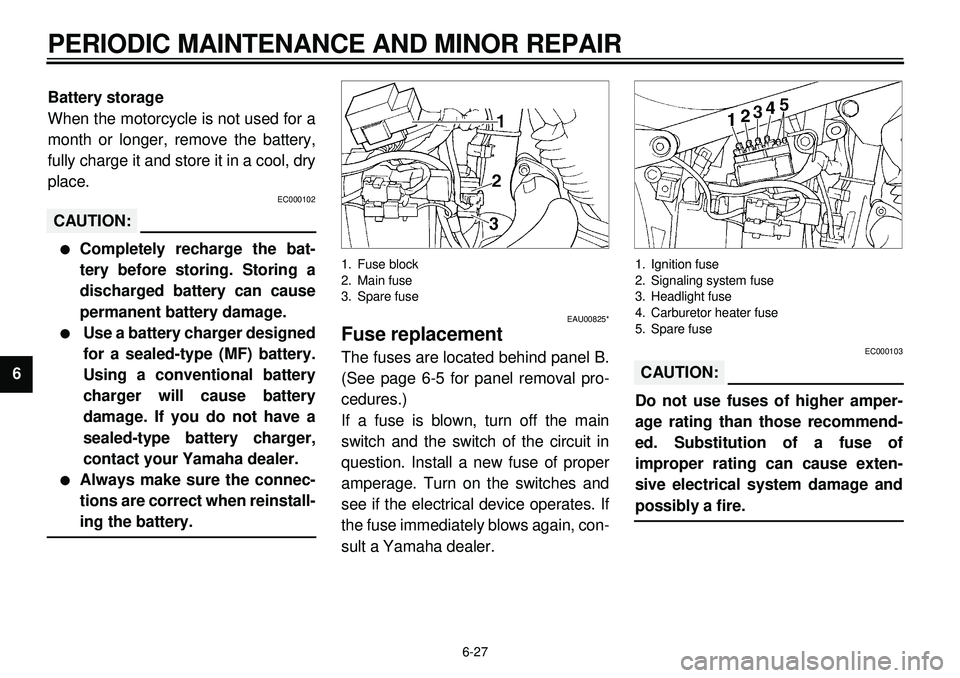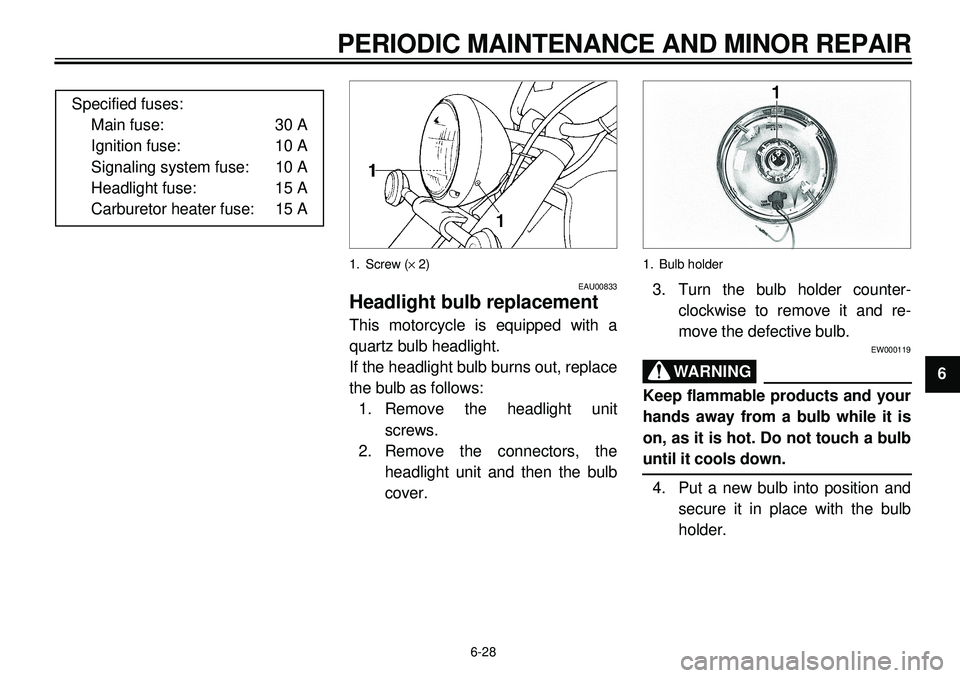YAMAHA XVS650A 2001 Manual PDF
Manufacturer: YAMAHA, Model Year: 2001, Model line: XVS650A, Model: YAMAHA XVS650A 2001Pages: 101, PDF Size: 6.77 MB
Page 71 of 101

6-25
PERIODIC MAINTENANCE AND MINOR REPAIR
1
2
3
4
56
7
8
9
EAU02939
Front fork inspectionVisual check
EW000115
WARNING
Securely support the motorcycle sothere is no danger of it falling over.
Check for scratches or damage on the
inner tube and excessive oil leakage
from the front fork.
Operation check
1. Place the motorcycle on a level
place.
2. Hold the motorcycle in an upright
position and apply the front brake.
3. Push down hard on the handle-
bars several times and check if
the fork rebounds smoothly.
EC000098
CAUTION:
If any damage or unsmooth move-
ment is found with the front fork,consult a Yamaha dealer.
EAU00794
Steering inspectionPeriodically inspect the condition of
the steering. Worn out or loose steer-
ing bearings may be dangerous. Place
a stand under the engine to raise the
front wheel off the ground. Hold the
lower end of the front forks and try to
move them forward and backward. If
any free play can be felt, ask a
Yamaha dealer to inspect and adjust
the steering. Inspection is easier if the
front wheel is removed.
EW000115
WARNING
Securely support the motorcycle sothere is no danger of it falling over.
Page 72 of 101

6-26
PERIODIC MAINTENANCE AND MINOR REPAIR
1
2
3
4
56
7
8
9
EAU01144
Wheel bearingsIf there is play in the front or rear wheel
hub or if the wheel does not turn
smoothly, have a Yamaha dealer in-
spect the wheel bearings.
EAU00800
BatteryThis motorcycle is equipped with a
sealed-type battery. Therefore it is not
necessary to check the electrolyte or
fill the battery with distilled water.l
If the battery seems to have dis-
charged, consult a Yamaha deal-
er.
l
If the motorcycle is equipped with
optional electrical accessories,
the battery tends to discharge
more quickly, so be sure to re-
charge it periodically.
EC000101
CAUTION:
Never try to remove the sealing
caps of the battery cells. The bat-tery will be damaged.
EW000116
WARNING
Battery electrolyte is poisonous
and dangerous, causing severe
burns, etc. It contains sulfuric acid.
Avoid contact with skin, eyes or
clothing.
ANTIDOTE:l
EXTERNAL: Flush with water.
l
INTERNAL: Drink large quanti-
ties of water or milk. Follow
with milk of magnesia, beaten
egg, or vegetable oil. Call a
physician immediately.
l
EYES: Flush with water for
15 minutes and get prompt
medical attention.
Batteries produce explosive gases.
Keep sparks, flame, cigarettes etc.,
away. Ventilate when charging or
using in an enclosed space. Always
shield your eyes when working near
batteries. KEEP OUT OF REACH OF
CHILDREN.
Page 73 of 101

6-27
PERIODIC MAINTENANCE AND MINOR REPAIR
1
2
3
4
56
7
8
9Battery storage
When the motorcycle is not used for a
month or longer, remove the battery,
fully charge it and store it in a cool, dry
place.
EC000102
CAUTION:l
Completely recharge the bat-
tery before storing. Storing a
discharged battery can cause
permanent battery damage.
l
Use a battery charger designed
for a sealed-type (MF) battery.
Using a conventional battery
charger will cause battery
damage. If you do not have a
sealed-type battery charger,
contact your Yamaha dealer.
l
Always make sure the connec-
tions are correct when reinstall-ing the battery.
1. Fuse block
2. Main fuse
3. Spare fuse
EAU00825*
Fuse replacementThe fuses are located behind panel B.
(See page 6-5 for panel removal pro-
cedures.)
If a fuse is blown, turn off the main
switch and the switch of the circuit in
question. Install a new fuse of proper
amperage. Turn on the switches and
see if the electrical device operates. If
the fuse immediately blows again, con-
sult a Yamaha dealer.
1. Ignition fuse
2. Signaling system fuse
3. Headlight fuse
4. Carburetor heater fuse
5. Spare fuse
EC000103
CAUTION:
Do not use fuses of higher amper-
age rating than those recommend-
ed. Substitution of a fuse of
improper rating can cause exten-
sive electrical system damage andpossibly a fire.
Page 74 of 101

6-28
PERIODIC MAINTENANCE AND MINOR REPAIR
1
2
3
4
56
7
8
9 Specified fuses:
Main fuse: 30 A
Ignition fuse: 10 A
Signaling system fuse: 10 A
Headlight fuse: 15 A
Carburetor heater fuse: 15 A
1. Screw (´ 2)
EAU00833
Headlight bulb replacementThis motorcycle is equipped with a
quartz bulb headlight.
If the headlight bulb burns out, replace
the bulb as follows:
1. Remove the headlight unit
screws.
2. Remove the connectors, the
headlight unit and then the bulb
cover.
1. Bulb holder3. Turn the bulb holder counter-
clockwise to remove it and re-
move the defective bulb.
EW000119
WARNING
Keep flammable products and your
hands away from a bulb while it is
on, as it is hot. Do not touch a bulbuntil it cools down.
4. Put a new bulb into position and
secure it in place with the bulb
holder.
Page 75 of 101

6-29
PERIODIC MAINTENANCE AND MINOR REPAIR
1
2
3
4
56
7
8
9
EC000105
CAUTION:
Avoid touching the glass part of a
bulb. Keep it free from oil; other-
wise, the transparency of the glass,
life of the bulb, and luminous flux
will be adversely affected. If oil gets
on a bulb, thoroughly clean it with a
cloth moistened with alcohol or lac-quer thinner.
5. Install the bulb cover, connectors
and headlight unit. Ask a Yamaha
dealer to adjust the headlight
beam if necessary.
1. Screw (´ 2)
EAU00855
Turn signal and taillight bulb
replacement1. Remove the screws and the lens.
2. Push the bulb inward and turn it
counterclockwise.
XVS6501. Screw (´ 2)3. Place a new bulb in the socket.
Push the bulb inward and turn it
clockwise until it engages into the
socket.
4. Install the lens and the screws.
Page 76 of 101

6-30
PERIODIC MAINTENANCE AND MINOR REPAIR
1
2
3
4
56
7
8
9
XVS650A1. Screw (´ 3)
EC000108
CAUTION:
Do not over-tighten the screws asthe lens may break.
EAU01579
Supporting the motorcycleSince the Yamaha XVS650/XVS650A
has no centerstand, follow these pre-
cautions when removing the front and
rear wheel or performing other mainte-
nance requiring the motorcycle to
stand upright. Check that the motor-
cycle is in a stable and level position
before starting any maintenance. A
strong wooden box can be placed un-
der the engine for added stability.
Front wheel service
To stabilize the rear of the motorcycle,
either use a motorcycle stand or place
a motorcycle jack under the frame in
front of the rear wheel to prevent it
from moving from side to side. Then
use a motorcycle stand to elevate the
front wheel off of the ground.
Rear wheel service
Use a motorcycle stand or motorcycle
jack to elevate the motorcycle so the
rear wheel is off the ground. Alterna-
tively, two jacks can be placed under
the frame or swingarm.
Page 77 of 101

6-31
PERIODIC MAINTENANCE AND MINOR REPAIR
1
2
3
4
56
7
8
9
1. Speedometer cable
EAU00894
Front wheel removal
EW000122
WARNING
l
It is advisable to have a
Yamaha dealer service the
wheel.
l
Securely support the motor-
cycle so there is no danger of itfalling over.
1. Remove the speedometer cable
from the front wheel side.
1. Axle
2. Pinch bolt2. Loosen the pinch bolt and wheel
axle.
3. Elevate the front wheel by placing
a suitable stand under the en-
gine.
4. Remove the wheel axle and the
front wheel.NOTE:Do not depress the brake lever whenthe disc and caliper are separated.
1. Speedometer gear unit housing
EAU01394
Front wheel installation1. Install the speedometer gear unit
into the wheel hub. Make sure the
wheel hub and the speedometer
gear unit are installed with the
projections meshed into the slots.
2. Lift up the wheel between the
front fork legs and guide the brake
disc between the brake pads.
Make sure the slot in the speed-
ometer gear unit fits over the stop-
per on the front fork outer tube.
3. Install the wheel axle and let the
motorcycle down.
Page 78 of 101

6-32
PERIODIC MAINTENANCE AND MINOR REPAIR
1
2
3
4
56
7
8
9 4. Push down hard on the handle-
bars several times to check for
proper fork operation.
5. Tighten the wheel axle to the
specified torque.
6. Install the pinch bolt and tighten it
to the specified torque.
7. Install the speedometer cable.Tightening torque:
Wheel axle:
59 Nm (5.9 m·kg)
Pinch bolt:
20 Nm (2.0 m·kg)
1. Adjusting nut
2. Brake rod
3. Brake torque rod bolt (´ 2)
4. Brake torque rod
EAU01350*
Rear wheel removal
EW000122
WARNING
l
It is advisable to have a
Yamaha dealer service the
wheel.
l
Securely support the motor-
cycle so there is no danger of itfalling over.1. Loosen the axle nut. Do not re-
move it.
2. Remove the brake torque rod bolt
on the brake shoe plate side.
3. Loosen the brake torque rod bolt
on the swingarm side.
4. Remove the brake pedal free play
adjusting nut and then the brake
rod from the brake cam lever.
5. Remove panel A. (See page 6-5
for removal procedures.)
Page 79 of 101

6-33
PERIODIC MAINTENANCE AND MINOR REPAIR
1
2
3
4
56
7
8
9
1. Bolt (´ 4)
2. Final gear case
3. Axle nut6. Remove the bolts that secure the
final gear case to the swingarm.
7. Elevate the rear wheel off of the
ground.
8. Pull the wheel backward while
supporting the drive shaft to re-
move the wheel, axle, final gear
case and drive shaft as an assem-
bly.
1. Middle drive shaft joint
2. Drive shaft
EAU01563
Rear wheel installation1. Install the rear wheel, axle, final
gear case and drive shaft as an
assembly by pushing the wheel
forward and guiding the drive
shaft into the middle drive shaft U-
joint.
2. Install the bolts that secure the fi-
nal gear case to the swingarm
and tighten to the specified tight-
ening torque.
Specified torque:
Final gear case bolts:
90 Nm (9.0 m·kg)
3. Insert the brake rod into the brake
cam lever and install the brake
pedal free play adjusting nut.
4. Install the brake torque rod bolt
and tighten both bolts to the spec-
ified tightening torque.
5. Install panel A.
6. Let the motorcycle down.
7. Tighten the axle nut to the speci-
fied tightening torque.
8. Adjust the rear brake pedal free
play. (See page 6-20.) Specified torque:
Brake torque rod bolts:
20 Nm (2.0 m·kg)
Specified torque:
Axle nut:
92 Nm (9.2 m·kg)
Page 80 of 101

6-34
PERIODIC MAINTENANCE AND MINOR REPAIR
1
2
3
4
56
7
8
9
EAU01008
TroubleshootingAlthough Yamaha motorcycles receive
a rigid inspection before shipment from
the factory, trouble may occur during
operation.
Any problem in the fuel, compression,
or ignition systems can cause poor
starting and loss of power. The trou-
bleshooting chart describes a quick,
easy procedure for making checks.
If your motorcycle requires any repair,
bring it to a Yamaha dealer. The skilled
technicians at a Yamaha dealership
have the tools, experience, and know-
how to properly service your motor-
cycle. Use only genuine Yamaha parts
on your motorcycle. Imitation parts
may look like Yamaha parts, but they
are often inferior. Consequently, they
have a shorter service life and can
lead to expensive repair bills.